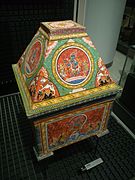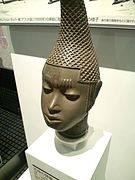National Museum of Ethnology
The National Museum of Ethnology ( Japanese 国立 民俗学 博物館 , Kokuritsu Minzokugaku Hakubutsukan , English National Museum of Ethnology ) was founded in 1974 by the later first director Umesao Tadao . The building was designed by Kishō Kurokawa and opened in November 1977. The museum - it is one of the largest in the world - is located in the middle of the area that was used for the world exhibition Expo '70 in the city of Suita ( Osaka prefecture ) and which subsequently became the "Expo Memorial Park" (万博 記念 公園, Bampaku kinen kōen) has been converted. The usual abbreviation for the museum is "Mimpaku" (民 博).
investment
The facility blends in harmoniously with the park area, whereby the architect kept the height as low as possible. The museum, which you enter from the east (“E” on the map), is divided into various interconnected blocks. The upper floors can be reached via six stairwells equipped with elevators, which are cylindrical and tower above the building complex. The ground floor is for the most part taken up by the magazines, the spacious exhibition area is on the first floor. Umesao attached importance to the use of the technology for data acquisition from the beginning, almost every object was and is being photographed while rotating. Terminals in the exhibition area allowed public access to the data from the start. The museum has a circular building for special exhibitions (S) and a lecture hall (V).
Showrooms
- Oceania 660 m²
- America's 320 m²
- Europe 250 m²
- Africa 500 m²
- Asia 4270 m²
- West Asia 310 m²
- South Asia 600 m²
- Korea 330 m²
- China 660 m²
- Southeast Asia 330 m²
- Central and North Asia 310 m²
- Ainu 270 m²
- Japan 1460 m²
Databases and Library (2018)
The collection comprises 343,581 objects, of which 178,864 are non-Japanese and 164,717 are Japanese. There are also 8168 moving images, 62,651 sound recordings and 70,819 audiovisual material. The library has 670,000 books, of which 271,000 are in Japanese and 399,000 are in foreign languages. 17,000 magazines are held, 10,000 in Japanese and 7,000 in foreign languages.
The object database contains basic information on 283,275 objects which contain pictures, dimensions and weight, place of origin and culture as well as the date of acquisition for each name. Another database with more detailed information describes 264,429 objects, of which information on 68,019 objects is publicly available.
Illustrations
Characteristics
- Museum area: 40,821 m²
- Built-up area: 18,177 m²
- Floor area: 52,648 m²
- Top floor: 846 m²
- 3rd floor: 7,207 m² (research)
- 2nd floor: 7,340 m² (research, library, administration)
- 1st floor: 16,830 m² (exhibition, administration)
- Ground floor: 17,410 m² (entrance area, magazine)
- Basement floor: 3,015 m²
See also
literature
- Ōshita, Atsushi: Minzokugaku Hakubutsukan In: Zenkoku bijutsukan gaido. Bijutsukan Shuppansha Tokyo, 1981. p. 245.
Web links
Remarks
- ↑ There are terminals on the inside behind the horizontal metal cylinders.
- ↑ Umesao Tadao (梅 棹 忠 夫; 1920–2010) was an ethnologist, information scientist and futurologist with a wide range of interests.
Coordinates: 34 ° 48 ′ 46.3 " N , 135 ° 31 ′ 46.9" E










